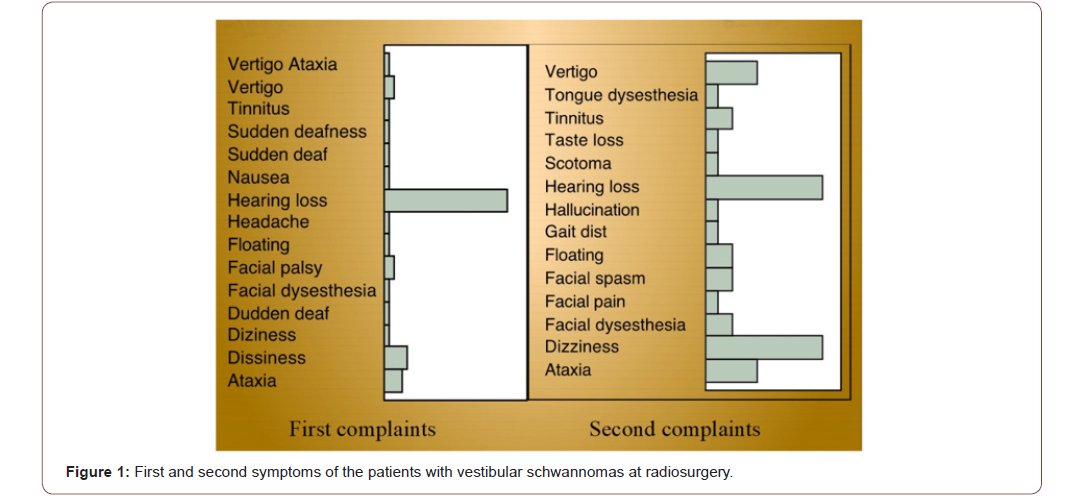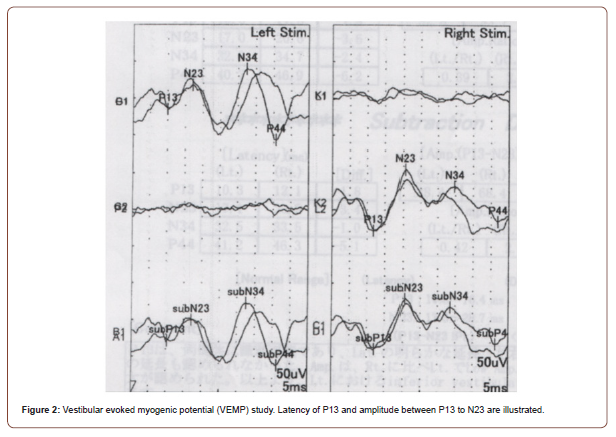 Short Communication
Short Communication
Physiological Aspects of Vestibular Schwannoma Treated with Radiosurgery
Yoshihisa Kida1* and Takaharu Yamauchi2
1Gamma Knife Center, Okuma Hospital, Nagoya, Japan
2Clinical Laboratory Department, Okuma Hospital, Nagoya, Japan
Yoshihisa Kida, Gamma Knife Center, Okuma Hospital, 2-9-34, Ohzone, Kitaku, Nagoya, Japan.
Received Date: February 16, 2021; Published Date: March 01, 2021
Abstract
Disequilibrium is one of the most popular symptoms of vestibular schwannoma, next to the hearing disturbance and tinnitus. In our institute, the cases with vestibular schwannoma were concurrently investigated with neurophysiological studies like pure tone hearing of Gardner-Robertson method (GR), auditory brainstem response (ABR), vestibular evoked myogenic potential (VEMP) and Stabilometry. Among them, VEMP study gives us the most valuable informations. In fact, both qualitative and quantitative improvements of VEMP have been verified in association with the symptomatic recovery of disequilibrium.
Keywords: Acoustic tumor; Disequilibrium; Dizziness; Gamma knife; Physiological study; Radiosurgery; Vestibular schwannoma; VEMP
Introduction
Vestibular schwannomas have been considered to be a one of the best indication for radiosurgery. In reality, tumor control after gamma knife treatment are reportedly very excellent. In spite of excellent tumor control, functional outcomes like hearing ability are not so great. Hearing preservation have been achieved mostly for the cases within normal range at the first radiosurgery. Persistent disequilibrium is the another problem for the patients before and during follow-up period.
Clinical Cases and Methods
Among 50 cases treated in our institute since July 2016, the most popular symptoms at the radiosurgery are hearing disturbances including hearing loss, tinnitus or sudden deafness (Figure 1). In addition, dizziness, vertigo, ataxia and floating sensation are known to be next familiar symptoms of this disease. In addition to the radiological studies with CT or MRI, the functional studies after radiosurgery, like pure-tone hearing study (G-R), auditory brainstem response (ABR), vestibular evoked myogenic potential (VEMP), stabilometry are routinely performed. After the initial study at the radiosurgery, the subsequent examinations are carried out periodically with every 3 to 6 month intervals.
Results
In first 50 cases treated in our hospital, hearing disturbance with G-R study is most remarkable. In the studies with ABR, low amplitude of the affected side is prominent in many cases and delayed propagation time from I to V waves are often noted. The specific changes of VEMP are available in many cases, chiefly in terms of delayed latency of P13, and the decreased amplitude, which is estimated by the hight from the bottom of P13 to the top of N23 as shown in (Figure 2). Subsequent changes of latency of P13 as well as the amplitude are marked in many cases. These changes are often moving parallel to the recovering clinical symptoms like dizziness, floating sensation and ataxia, as shown one example in (Figure 3) (Table 1).



Table 1: Summary of the finding of physiological studies. Pure tone hearing and ABR were not significantly improved. Conversely, VEMP study demonstrated a remarkable recovery of p13 latency.

Conclusion
The most popular symptoms of vestibular schwannoma are the hearing impairment and related signs. However, many patients are often suffering from disequilibrium before and after the treatment [1-4]. Functional studies with hearing ability, ABR and VEMP, Stabilometry may indicate the serial changes of neurophysiological function [5]. Special importance is the findings with VEMP study, indicating the effects of radiosurgery better than those after microsurgery [6, 7]. Since the P13 is readily and constantly captured, these objective changes can be detected quantitatively after radiosurgery, which may be more accurate than the subjective evaluation with Dozziness Handicap Inventry (DHI) [8]. In conclusion, neurophysiological studies show us various functional informations after radiosurgery. Among them, VEMP study demonstrates the changing and improving function of disequilibrium clearly.
Acknowledgement
None.
Conflict of Interest
No conflict of interest.
References
- Dayal M, Perez Anjugar A, Chuang C, Parsa AT, Barani IJ (2013) Management of vestibular schwannoma: focus on vertigo. CNS Oncol 2(1): 99-104.
- Von Kirschbaum C, Gurkov R (2016) Audiovestibular function deficits in vestibular schwannoma. Biomed Res Int 4980562.
- Wackym PA, Hannley MT, Runge-Samuelson CL, Jensen J Zhu YR (2008) Gamma knife surgery of vestibular schwannomas: longitudinal changed in vestibular function and measurement of the Dizziness Handicap Inventry. J Neurosurg 109: 137-143
- Stavas MJ, Matthew, Carlson ML, Attia A, Jacobson GP, et al. (2014) Does radiation dose to the vestibule predict changes in balance function and patients perceived dizziness following stereotactic radiotherapy for vestibular schwannoma? Am J Otolaryngol 35(5): 565-571.
- Ojala M, Palo J (1991) The aetiology of dizziness and how to examine a dizzy patient. Ann Med 23(3): 225-230.
- Lynn SG, Driscoll CL, Harmer SG, Beatty CW, Atkinson EJ (1999) Assessment of disequilibrium after acoustic neuroma removal. Am J Otol 20(4): 484-494.
- Uehara N, Tanimoto H, Nishikawa T, Katsunuma S (2011) Vestibular dysfunction and compensation after removal of acoustic neuroma. J Vestib Res 21(5): 289-295.
- Wackym PA, Hannley MT, Runge-Samuelson CL, Jensen J, Zhu YR (2008) Gamma knife surgery of vestibular schwannomas: longitudinal changes in vestibular function and measurement of the Dizziness Handicap Inventory. J Neurosurg 109:137-143.
-
Yoshihisa Kida, Takaharu Yamauchi. Physiological Aspects of Vestibular Schwannoma Treated with Radiosurgery. On J Otolaryngol & Rhinol. 4(3): 2021. OJOR.MS.ID.000590.
-
Vestibular schwannoma, Hearing, Tumor, Dizziness, Vestibular schwannoma, Radiosurgery, Auditory brainstem response, Deafness, Tinnitus.
-

This work is licensed under a Creative Commons Attribution-NonCommercial 4.0 International License.






